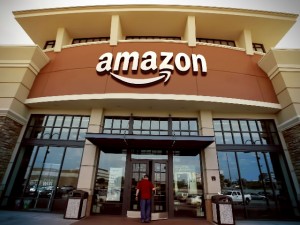I know of a chain of electronics stores with over 1000 locations. Right now, their share price is nose-diving, leadership is in disarray and the future of the company is in substantial doubt. They’re scrambling to downsize stores, cut costs and reestablish a relevant consumer value proposition – largely because they say, you – Amazon, are killing them and consumers are “showrooming” them to death. You see, this chain is currently thinking that this whole calamity is largely about the size of their stores and the prices of their products. But what they’re missing is that this is really about redefining intrinsic purpose of the store to begin with. It’s not just about simply making the store smaller or more like the web – it’s about inventing something completely different – something new and exciting! 
So, here’s the idea…
You buy this chain, instantly giving you over 1000 points in the market where consumers can have a hands-on experience with the Kindle Fire – a key element that’s currently missing from your Kindle adoption strategy. In these unique store environments, you can actually get customers touching and experiencing the Kindle Fire, much the way Apple customers can with the iPad. In essence, these stores become an experiential entry point for the Amazon franchise of products.
But that’s just the beginning; you set these stores up completely differently from the way they are now. You transform them into part gallery, part workshop! The gallery portion of the store has beautiful and interactive displays where customers can play and learn about cool new products. Here you can merchandise products across a range of entertainment and electronics categories. The workshop portion of the store is where you could offer customers classes on how to use the products they just bought; buy a DSLR camera and attend the free “intro to DSLR” workshop for or buy a home theatre system and get a home theatre set up course free – and all in awesome open-air classrooms. Customers would cease to think of the store as merely a distribution point and begin to see it as an experiential center that sells things of intangible value! Any comparison to other run of the mill stores would be frutiless!
For the thousands of products you don’t happen to stock in-store, you can have interactive digital displays similar to what Adidas and Intel created for Adiverse – giving shoppers an easy way to sift through and buy from your entire array of products. It won’t matter what’s in stock and what’s not. It’s all available within 24 hours, shipped to wherever the customer desires!
You could also tie your online and offline experiences together with an app (maybe just for Amazon Prime customers) that recognizes the customer when they enter the store and offers up items of interest in-store, based on their online browsing. Bringing the shopper’s online and offline worlds together will allow you to tailor the shopping experience to individual needs and preferences. It’ll be as though the store exists just for them that day!
And having these new physical points in the market would give online customers the option of picking up their order at their local Amazon store, that day – which would also help with the efficiency of your same-day shipping program.
These new Amazon playgrounds, would become living, breathing experience centers where shoppers could go to learn and play, thus differentiating them completely from the Walmarts and Targets of the world. These would cease to be mere electronics stores as they are now, instead morphing into fantastic consumer lifestyle amusement parks that offer a completely unique level of value and would ultimately introduce the Amazon proposition to those who may not currently be Amazon shoppers.
Now, I know that many would suggest that Amazon’s strength lies in it’s pure-play approach to online and that they’ve been successful largely because they don’t operate physical stores. But that’s precisely the point. These new Amazon locations would not be stores, as we know them today.
In essence, from the ashes of an old, tired chain, you’d be creating an entirely new retailing model. You’d be redefining the shopping experience.
What do you say? Deal?
Look for my book The Retail Revival: Re-Imagining Business for The New Age of Consumerism, coming to stores January of 2013!

